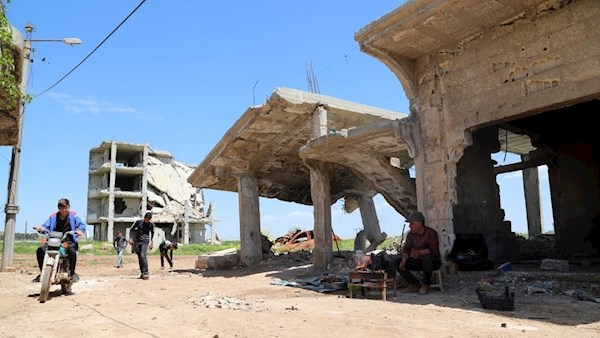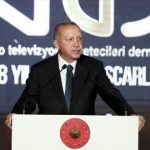After years of rising tensions between Turkey and the US over the situation in northern Syria, an unexpected rapprochement has pulled the two countries back from possible conflict.
Relations between the two countries had deteriorated over Turkish opposition to the US alliance with Kurdish fighters in northern Syria, and Turkey’s recent purchase of a Russian air defence missile system. In response, the US kicked Turkey out of its F-35 fighter programme in July.
But in August, Turkey and US announced they would collaborate to establish safe zones along the Syrian-Turkish border, managed by a joint operations centre in Turkey.
Turkey has long demanded these buffer zones across its northern border with Syria to protect against possible assaults from the Kurdish People’s Protection Units, or YPG, which leads the Syrian Democratic Forces. The safe zone will effectively serve as a buffer between the YPG-controlled area and the Turkish border, and also combat the ongoing threat of Islamic State (IS) in the region.
The Turks and Americans are yet to agree on the size of the buffer zone – with Turkey pushing for it to be larger than the US wants – and it remains unclear who will police it. But in late August, YPG leaders agreed to withdraw their troops from towns near the Turkish border in what the Pentagon said was a sign of “good faith”.
But why has the US begun to condone Turkish action in northern Syria, and why now?
Deteriorating relations
Although Turkey and the US both sought to displace the regime of Bashar al-Assad in Syria, their priorities in the region changed over time. When the US launched its coalition against IS in 2014, Turkey joined reluctantly amid fears that the fight would harm the Syrian rebels fighting against the Assad regime.
But while Turkey remained suspicious over the presence of the YPG in northern Syria, the US allied with these very forces to defeat IS and to balance Iranian influence in the region.
When US President Donald Trump declared IS had been defeated in December 2018 and that American troops would withdraw from Syria, Turkey’s President Recep Tayyip Erdoğan hurried to announce Turkish troops could replace the Americans in the region. Erdoğan has repeatedly stressed that Turkey will not harm Syrian Kurdish civilians, but rather target militant groups in the region, including the YPG which it sees as linked to the Kurdish separatist Kurdistan Workers’ Party, or PKK.
After the reaction in Washington to the decision to withdraw from Syria – which caused resignations and criticism from senior politicians – Trump reversed his decision. In early January the US government said it would not withdraw until the Turkish government guaranteed it would not to attack Syrian Kurds who had been part of the alliance fighting against IS. Turkey has not given this guarantee.
Mistrust has festered over alleged links with each of the allies’ foes, namely Turkey with IS fighters and the US with the YPG. Amid the tensions, the US embassy in Ankara remained vacant.
Pulling back from conflict
There are three reasons for the current rapprochement. The first is a growing desire from both sides to avoid conflict between their military personnel in the region. In 2018, Erdoğan threatened that any US soldiers who stood in the way of the Turkish invasion of Afrin, a Syrian enclave in northern Syria, with an “Ottoman slap”.
Ankara now seems more willing to collaborate with Washington. The welcome extended to the new American ambassador to Turkey, David Satterfield, at the presidential palace on August 28, signalled the allies are looking to build bridges.
The second is that Assad’s forces are encroaching into the last remaining opposition stronghold in Idlib with their Russian allies. Turkey is likely to face another stream of Syrian refugees across to its borders. The search for an agreement over safe zones in northern Syria comes to the fore as Erdoğan feels the brunt of his pro-refugee politics at home.
Since its invasion of Afrin, Turkey has sought to settle Syrian refugees in safe zones in the province. The newly proposed safe zones are likely to see a push for further refugee returns. Similar goals of returning refugees are also pushing other peace efforts in the region – notably between the US and Taliban in Afghanistan.
The third reason is more personal. Erdoğan says Trump has a feel for him. Both leaders are celebrity politicians, with their families at the foreground of their politics. They share anti-establishment mentalities, and use religious references and nationalist discourses to appeal to their supporters.
The Russian factor
Hanging over this rapprochement, however, is the issue of the Russian missiles. So far the Trump administration has not imposed economic sanctions on Turkey over the issue, despite criticisms from Congress over the risks it poses to NATO security. Turkey said it would not activate the missiles until April 2020, allowing negotiation channels with the US over northern Syria to remain open.
Turkey has been a proactive voice against military assaults by the Assad regime in northern Syria, yet it has remained quiet on the Russian-Syrian alliance in the region. Since the failed coup attempt in 2016, the Erdoğan regime has been increasingly pro-Putin, signalling it is turning its back on its traditional Western allies.
That’s why it’s so significant that Turkey and the US are searching for collaboration in the region despite their policy differences. In the Turkish case, this could be a way to enhance its buffer as Assad forces regain the northern provinces from the rebels. In the American case, it could be to expand its alliances to offset Russian and Iranian influence in the future Assad-ruled Syria.![]()
By Tarik Basbugoglu, Glasgow Caledonian University and Umut Korkut, Glasgow Caledonian University
Source: Irish Examiner
Tarik Basbugoglu, PhD Candidate, Glasgow Caledonian University and Umut Korkut, Chair professor, Glasgow Caledonian University
This article is republished from The Conversation under a Creative Commons license. Read the original article.



